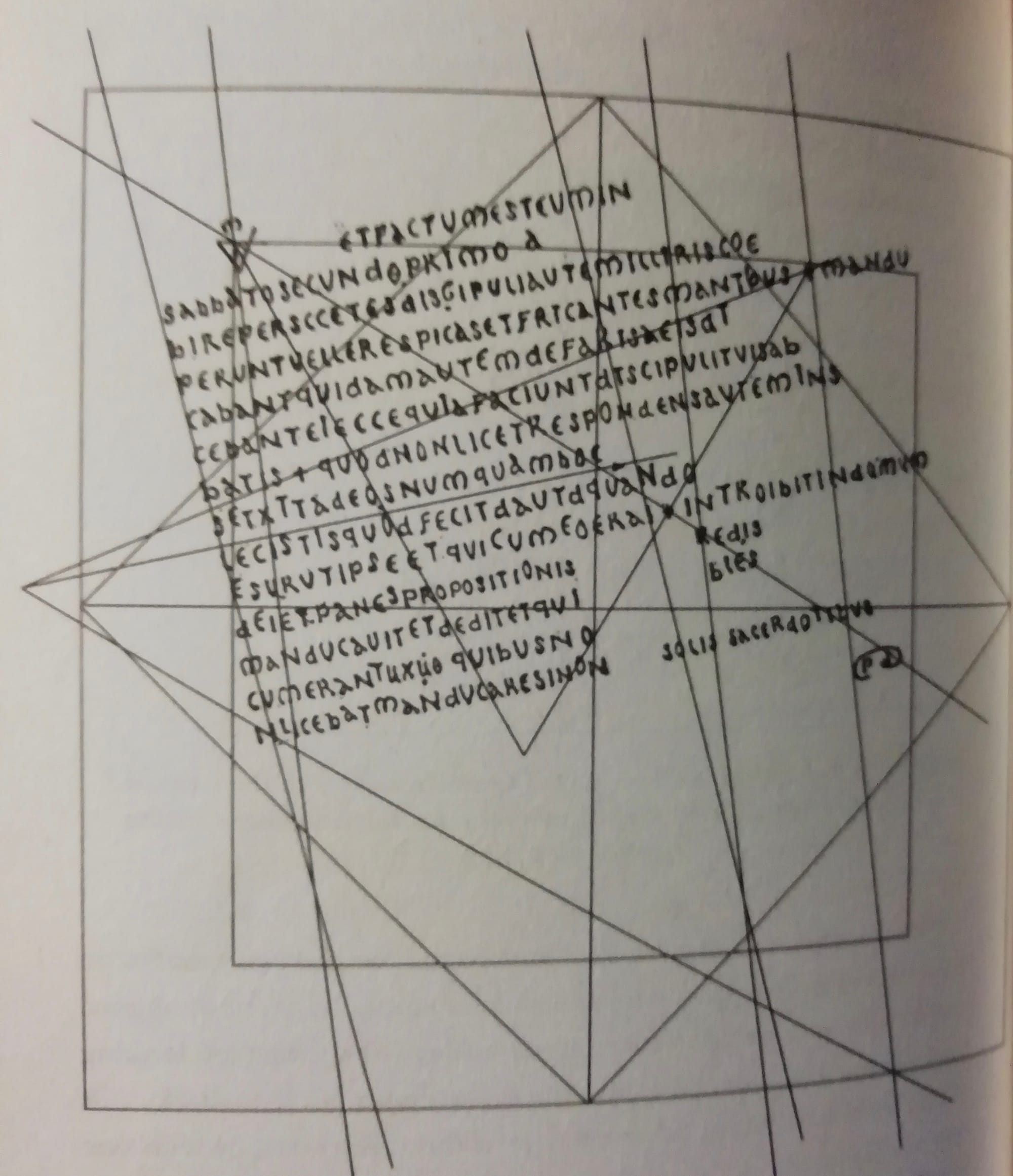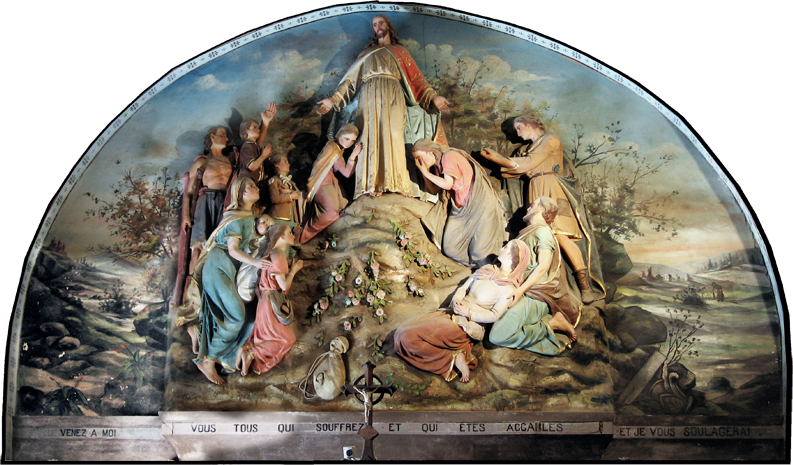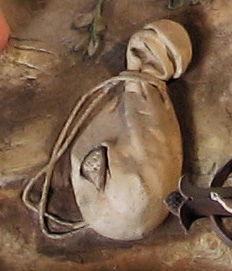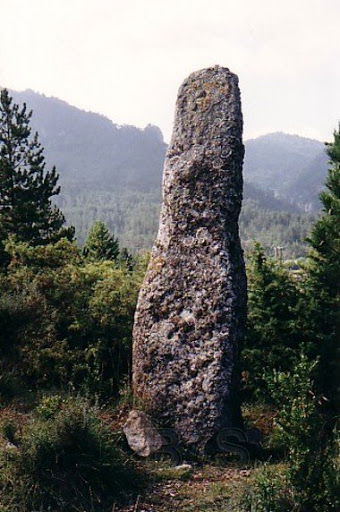The Parchment Mysteries in their geographical landscape.....?
I was recently perusing my old copies of the Rennes Observer (the journal of the now defunct Rennes Group) and in Issue 52 there was a short article written by Stephen Anderson about the 'original parchments' [of the Sauniere affair] held by Jean-Luc Chaumeil. Although they are called ‘parchments’ this is misleading. The documents that Chaumeil produced for the BBC Timewatch programme in 1996 are not parchment but paper, and photocopies at that. These ‘paper documents’ have written on them pieces of Latin text. The smaller Latin text was 'lifted’ from a biblical manuscript called the Codex Bezae which dates to around the 5th century. The other larger text, although claimed to be taken from a 19th century academic publication, is actually from another 5th-6th century manuscript called the Codex Brixianus [See HERE].
Having seen the work of my fellow researcher Paul Karren i am convinced that he has found a 'key' on the smaller document and therefore in light of Anderson's comments it became important which 'document' in the saga of Rennes-le-Chateau was the 'orignal'. This is because - in respect of the Dagobert document - there appear to be two different variations in the reproduction of the document doing the rounds. I have already touched upon this idea before. I had started with the premise that if there IS a code somewhere on the small document [as for example detected by Karren], and in this resepect i am not referring to the 'Dagobert text', it presumably must be on all the reproductions of this small text document. However this is not the case. If there is a code implied by the dots and dashes [as suggested by Karren] this only appears on one circulating image, and that is the first original diagram published by de Sede in his book Le Tresor Maudit [1967].
Henry Lincoln claimed he saw photos of the original documents and he described these photo's as having blue ink additions on the actual photo. He said later Plantard claimed these were Cherisey's 'confections' - claimed by Plantard to have been added to the photos. Lincoln went further - he said if the 'confections' were removed, what was left were the original documents.
Plantard said much more. He said the fourth parchment [implying that this was one single document] found by Sauniere was the original on which de Cherisey had devised a modified version. According to Plantard this document was orginally one document with a coded message on each side of the page. Plantard says the two texts interacted together, so for example, if the document was held up to the light and viewed 'something else' would be seen. This suggests a kind of superimposition technique - a technique of placing one image on top of an already-existing image, usually to add to an overall image effect, but also sometimes used to conceal something. The technique is used in cartography to produce photomaps & for superimposing grid lines & contour lines & and other linear or textual mapping features over aerial photographs.
If this is correct, then the original document was one, and someone must have separated out the two sides. This means that the images in the Sauniere 'mystery' are NOT the originals - because someone has modified them. Lincoln felt that Plantard was implying that Cherisey's chief modification of the single document was simply to reproduce the two sides of the same page as separate pages and not to the original scale.
Several years earlier Lincoln had said; "we were told that both ciphered texts were forgeries ...we challenged this assertion,.... M. Plantard conceded that the forgeries were closely based on the originals. In other words Cherisey hadnt 'concocted' them, but had copied them and Cherisey had only made a few additions. When these additions were deleted what remained were the original texts". This suggests that there was another document - the ORIGINAL OF THE ORIGINAL's - presumably in the posession of either Plantard or Cherisey and that together they manipulated the document into what we see today. And then added to these were Cherisey's alleged confections. And these confections were for Lincoln, the dots and dashes etc found on both documents.
Much later the authors Andrews and Schellenberger realised that Cherisey had added the cipher message [beregere pas de tentation] to produce the same information that the 'tilted square' had yielded within the large document itself. For them the cipher message 'identified a square to be placed on a map at 15 degrees to lines of latitude and longitude'. The purpose of Parchment 2 was seemingly to augment the map information in Parchment 1. However, as they noted, it was possible that someone could deduce the 'tilted square' with only an incomplete knowledge of the role of Parchment 1. On searching for the squares location, this someone would require some other data to 'break the deadlock'. Cherisey has added to the parchment [the cipher] to contribute to the 'preservation of knowledge'. He understood the 'titled square' geometry, according to Andrews and Schellenberger, and produced the cipher to produce the same end result. Andrews and Schellenberger also mention that the Devils Armchair may have been used in another shceme, which de Cherisey co-opted into the cipher.

Above - the double sided geometry now in alignment.
The tilted square was discovered on the larger document and when used in conjunction with the added cipher message it mapped out a specific geographical area - of landmarks around the two Rennes. Andrews & Schellenberger felt this was done so that the information from the tilted square would not be lost!
This is not as preposterous as it might seem. In August 1965 a document known as Les Descendants Mérovingiens ou l’énigme du Razes Wisigoth appeared. It was written by an annoymous Madeleine Blancasall, perhaps a name in honour of Mary Magdalene and the two rivers called the Blanque & and the Sals which flow through the village of Rennes-les-Bains. The document was deposited in the Bibliothèque Nationale of Paris and states that it was translated from the German by Walter Celse-Nazaire, again probably named after the patron saints of the church of Rennes-les-Bains.
There are several important 'developments' in this early 'text'. For example - part of the 'tresor de Rennes' is attributed to Dagobert II and the money he had access to as King of Austrasia. The other part of the treasure is a secret pertaining to Blanchefort and its guardians, which presumably means the Hautpoul family. We already have the involvement of the funerary stones of Marie de Negre in the affair from at least 1905. She is a descendant of these Blanchefort guardians.
But what we also see is via this document is the role of Abbe Boudet.
Gerard de Sede stated in one of his books [Rennes-le-Château: le dossier, les impostures, les phantasmes, les hypothèses [1988]] that he had told Plantard that the book by Boudet [La Vrai Langue Celtique] might be coded. The response he said he received was less than enthusiastic and de Sede assumed that his idea was dismissed. This seems strange because in 1967 de Sede was talking about the input of Boudet via his Le Tresor Maudit and we know that Plantard had a hand in this manuscript. This Blancasall document shows that Plantard & Cherisey indeed were very interested in Abbe Boudet.
Blancasall writes that "assisted by Marie Denarnaud, his [Sauniere] first concern will be to obliterate the tombstone of the Marquise de Blanchefort. Then, he takes walks alone in the countryside - on the hill of Patiaces and Pla de la Coste. In a few days, he has found the trail signs leading to the famous menhir called cheval de dieu and the cross on the ?stone of crete [?or stone ridge] 681yards from the shepherdess of the church of Rennes-les-Bains. He then goes to Abbe Boudet for advice on this daemon de guardian".
In 1965 [a snap shot of the so-called Priory of Sion information as it was being disseminated then] this text described elements of the 'bergere' cipher message in a geographical context.
Were Andrews & Schelleneberger right when they suggested the bergere cipher invented by Cherisey to encode the same 'hidden information' in the parchment via the tilted square had an older system which included other landmarks, especially this 'shepherdess of the church of Rennes-les-Bains?
Note Cherisey writes 'La Bergere de l'eglise de Rennes-les-Bains'. The shepherdess of the church of Rennes-les-Bains? Which shepherdess is associated with this church? Perhaps Cherisey's 'La bergere' is meant to read A bergère as an enclosed upholstered French armchair (fauteuil)] i.e. the Devils Armchair [a local name of a landmark close to the church of Rennes-les-Bains and attested to at least as early as 1920]? We know Cherisey likes word play and innuendo - La and 'A'? If so then is it this Devils Armchaie which is 681 [a nod to the cipher message again?] toises from the thirty-five centimetre cross on a stone ridge?
What is interesting is that there is a local shepherdess of Rennes-les-Bains associated also with a Devil and a treasure. Her name is Catherine Planel and it is this story which Labouïsse-Rochefort believed was the source of the Devils treasure legend at Blanchefort. All the legends about a treasure concern the Hautpoul family, specifically Blaise Hautpoul and Henry Hautpoul, father and son respectively. One legend revolves around Blanchefort and Rennes-les-Bains and a shepherdess [which Cherisey seems to be referring to], the other legend pertains to a shepherd and Rennes-le-Chateau.
Henry was son of Blaise d'Hautpoul. All lovers of the mystery of Rennes know Blaise at least in name, for in the year 1645, there was supposed to have been a discovery of a fabulous treasure by the shepherd Ignace Paris, in one version, and a shepherdess in a second version, on land owned by Blaise d'Hautpoul. Labouisse-Rochefort, told the legend of the treasure of Blanchefort that was protected by the devil. It dates back to at least the late eighteenth century and takes place in the castle of Blanchefort, located a few miles from Rennes-les-Bains. The devil's treasure was 19 and a half million gold coins and a shepherdess surprised him one day when he was counting out his gold coins. By the time the villagers were called to see the spectacle the devil and the treasure had disappeared. The farmers appealed to a sorcerer in Limoux to enter into a relationship with Satan to recover the treasure, which he accepted only on the condition that he be assisted by his countrymen, but the 'sorcerer' could not count on their support because they fled frightened, after hearing the noise made by the demon. The experiment was abandoned. Auguste de Labouïsse-Rochefort added [in regards to the legend] - "The annoying thing about this affair was that M. de Fleury, then Lord of the villages of Montferrand, Bains, Rennes, as well as the ruins of Blanchefort, wanted to bring an action against them for having attempted to violate his lands…!' This suggest a literal event that did happen which later turned into a legend. De Sede dates the legend to at least 1767, when the Fleury family first arrived at Rennes-les-Bains.
Cherisey places the legend about the shepherdess at Rennes-les-Bains in a geographical aspect in his alleged manuscript Stone & Paper. For him the legend of the shepherdess describes her seeing the Devil spread the treasure in the sun - 'the entire beautiful hill was lit by it'. This particular 'beautiful hill' is known in the local literature as the 'bonne colline' and refers to Mont Serbairou. [Interestingly, de Sede reports part of this legend, saying that the wizard managed to get hold of 'one string of his [the Devil] moneybag'. I suggest that the so called Fleury tableau, in Sauniere's church refers to this legend - a beautiful hill, with a money bag shown with ropes. So perhaps the Fleury tableau, fleury Mount- is really the local 'bonne colline', the beautiful hill of Mount Serbairou?

Henry Lincoln himself speculated that Sauniere may have left clues in his church regarding the nature of any 'treasure' he may have found. In fact, Lincoln said, the clues to the treasure were the 'church itself'. As part of these studies Lincoln analysed the Fleury tableau and which i have illustrated above. Lincoln advocated a kind of modern day 'catchphrase' system of analysis ['Catchphrase' is currently a progamme on TV where popular catchphrases are represented by a piece of animation and from the animation clues the catchphrase is to be identified] - where you simply 'say what you see'. So on this Fleury tableau what is mainly seen is a flower strewn landscape, a Terrain Fleury if you will .... or, a 'flowery hill' - the colline fleurie. Lincoln wondered if Sauniere might have been trying to indicate the Fleury domains via this tableau with this flower strewn hill.
The Fleury's were important local lords of the area of Rennes-le-Chateau and Rennes-les-Bains. A famous one intimately linked to the 'mystery' for example is one Paul Urbain de Fleury, who is said to have donated a mysterious painting of Christ to the church at Rennes-les-Bains. The Fleury's also married into the Blanchefort/Hautpoul family .... (for example, Paul-François-Vincent de Fleury, married 13 sept. 1767 Marie-Anne-Gabrielle-Élisabeth d’Hautpoul, daughter of François d’Hautpoul, baron de Rennes-les-Bains, Sgr de Montferrand, Bézis, marquis de Blanchefort).
Lincoln continues - asking whether this Fleury hill is therefore important because Sauniere has depicted on the hill a purse of gold. Is the purse of gold a subtle hint that a treasure is buried here? He perhaps was on the right track - long before Stone and Paper appeared, but for Cherisey the important mountain is Mont Serbairou.
Regarding the shepherdess of Rennes-les-Bains - Cherisey muses that if the she was 'dazzled' by the reflection of the gold, and not by the gold itself, it 'was because the sun was behind her and, therefore she was looking West. Therefore it was more important to know where the shepherdess was than where she was looking". Cherisey takes this opportunity to tell researchers to 'meditate about the mirror ... and to envisage ... how the stare and reflection are less important than going through the mirror and the anti-symmetrical phenomenon that opposes L '.
Cherisey also refers to several "cheval de dieu's" throughout his writings and interviews on the subject of Rennes. He says for example that " ... Berenger Sauniere found various signs left by Father Bigou. He often wandered in a land called 'Le Pla del Coste' and a strange chess came started between Roc Noir [Rokko Negro] and the Rocher Blanc [White Rock]. The priest found the famous standing stone, known as the Cheval de Dieu, and the thirty -five centimetre cross on a stone on a ridge mentioned by Father Boudet, located 681 toises [one toise equals 6 feet or 1.949 metres] from La Bergere de l'eglise de Rennes-les-Bains".
Cherisey, in other writings states that the Horse of God/Cheval de dieu relates to the Knights Tour on a chessboard, and to Chiron, and also to an area in Rennes-les-Bains - Mount Serbairou. On this mount, the shepherdess who noticed the reflection of a treasure, Cherisey remarked, had found two beautiful white standing stones very similar to a horse.
Cherisey also associates the Horse of God with the 9th Station of the Cross in the church at Rennes-le-Chateau. Another time he says that the most important Horse of God is the one that Eugene Delacroix painted in the Chapel of the Angels at Saint Sulpice church in Paris in 1861. Cherisey alludes to the text on the stele of the Marchioness of Blanchefort being created in 1861 and he says the text can only be decoded through Eugene Delacroix! He writes in Stone & Paper;
"Therefore the inscription engraved on the stele of the lady of Blanchefort, who died in 1781, was made between 1860 and 1910, and not, as some allege by Father Bigou. I do not know who wrote these texts, but one must admit that in those days there were people with real genius..."
He is suggesting perhaps Boudet as the originator?
He then has a bit of a giggle with us all saying Cheval de Dieu refers to his name because Philippe means 'lover of horses' [Philip is a male given name, derived from the Greek Φίλιππος Philippos, lit. "horse-loving" or "fond of horses", from a compound of φίλος (phílos, "dear", "loved", "loving") and ἵππος (hippos, "horse"] and Cherisey means 'friend of the Gods'. Although in actual fact Cherisey does not mean friend of the Gods, the nearest is Cherise: dearly held, precious. The straight translation of Cherisey into Greek is χαρούμενος which means happy, cheerful, joyful, merry. But we know Philippe de Cherisey is a master word manipulator and actor - after all, he once also said his name Cherisey came from the Cherusci who were the most celebrated of all the German tribes, and are mentioned by Cæsar as of the same importance as the Suevi, from whom they were separated by the Silva Bacensis.
Be that as it may there are several accounts of Sauniere wandering the countryside alone, usually in the vicinity of the land called 'Pla del Costa' - where a strange chess game started between Roc Noir [Rokko Negro] and the Rocher Blanc [White Rock]. The priest is said to have found the famous standing stone, known as the Cheval de Dieu, and the 35 centimetres high cross on a stone on a ridge, located 681 toises [one toise equals 6 feet from La Bergere 'de l'eglise de Rennes-les-Bains].
Below is an old photo of the Cheval de Dieu - which looks remarkably like the Peyro-Dreito stone [as depicted in The Testament of the Priory of Sion].
Above - the Menhir of Peyro-Dreito today.


